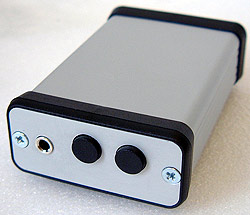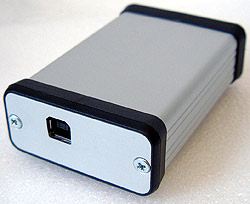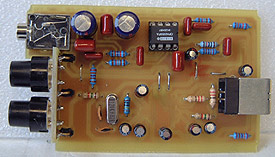Burning Blue Audio USB Headphone Amplifier Review
As
someone who spends a majority of the working day under the warm grip of a pair
of Grado SR-80 headphones, it's safe to say I put a lot of importance in how
the music I listen to sounds. After all, at $250 CDN a pair, Grado's SR-80's are worth
their weight in high-end audio 'gold' as it were. For the uninitiated, Grado headphones are
based on a dynamic transducer set in a non-resonant air chamber with
vented diaphragm and sport a frequency response of 20Hz-20kHz. The normal impedance of
the SR-80 headphones is 32 ohms, and the drivers are matched
to within 0.1dB. Basically, Grado's are killer headphones that offer superb sound clarity and warmth,
and would make angels weep with delight. They do look kind
of funny I have to admit though.
Why is all this relevant
when the product on the review table is actually something completely different?
Well, since Burning Blue Audio produce a $149USD
USB Headphone Amplifier that in their own words "uses a digital-analog converter
(DAC) designed explicitly for high quality headphone amplification," we want to
assure you that we're testing with headphones capable of distinguishing between
shoddy sound, and the good stuff we all crave. Now that you know what equipment
is involved in the testing lets begin.
The USB Headphone
Amplifier is actually a little aluminum box about the size of a package of
mints, and draws all power from the USB cable itself. From a distance the unit
does have the appearance of an MP3 player, but it is definitely not one. The
amplifier simply takes a digital signal from a USB connection and translates
that into an analog signal regular everyday headphones can pump out as sound.
There are two black buttons on the unit to control volume levels independently
of the computer itself, but neither were labeled on the unit we evaluated.
 
Burning Blue's
USB Headphone Amplifier has a decidedly home-built feel to it from the aluminum
project box casing down to the single-conductor PCB on the inside. Appearances aside,
it really is the audio quality that we're interested in, and if this unit is being
assembled in the back of a Seattle garage so be it - Apple started out this way
among countless other companies.
The USB Headphone Amplifier
was plugged into a Fujitsu P2110 notebook running WindowsXP for testing with a
6" USB which is included in the small package. Right off the bat we discovered the USB Headphone Amplifier
has a nasty habit of crashing the computer the instant a
CD being played over the device is ejected from the CDROM without first being shut
down in the CDPlayer control panel. Not good.
Installation consists of
plugging in the USB cable and allowing a few moments for WindowsXP to identify
the device, install drivers and assign audio to the unit. Since this is a USB
device, there is also some system work load imparted. When playing back
MP3's over the USB Headphone Amplifier the sound is automatically switched from
the internal "ALi Audio Wave" soundcard to the external "USB Audio CODEC." This
causes the headphone jack on the notebook (in this example) to cease functioning
as the audio is routed out to an external device.
The volume buttons on the unit
will control the device volume in the computer's mixer, but for things like
WinAMP there is no correlation. Also, at zero
volume levels during playback there is a soft level of static
in the background; somewhat akin to what you'll hear listening to
vinyl. The faint static goes away when the audio is
stopped, and interestingly enough the intensity changes from time to time and
even includes the odd click here and there.

Acoustically, the Burning Blue USB Headphone Amplifier does
increase sound levels with little if any distortion until the higher end of the
scale. The question as to whether this external audio codec is an improvement
over the internal AC'97 codec all comes down to what chipset the notebook
manufacturer uses, and what your audio settings are. While I know that the
internal sound of the Fujitsu P2110 pails in comparison to a real stereo, I
didn't find that the USB Headphone Amplifier offered any significant
improvement.
Amplifying the volume
is a short route to "improving" audio quality and I don't believe the
overall effect is positive especially when we consider the extra load placed on
a notebooks' processor by USB devices. Add to that random bits of [quiet] background static,
some clicks here and there, and the Burning Blue Audio
USB Headphone Amplifiers' price tag of $149 and we have a device which doesn't really
impress us all that much. The Burning Blue unit is on the right track, but right now this product just
doesn't offer everyday consumers that much value and quite frankly isn't something I would recommend.
Contents of Article: Burning Blue USB Headphone Amplifier
|
|
|
|
|

